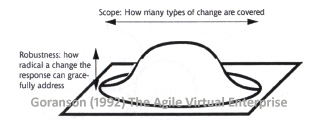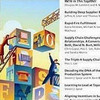 Although getting close to 20 years old now, The Agile Virtual Enterprise: Cases, Metrics, Tools
Although getting close to 20 years old now, The Agile Virtual Enterprise: Cases, Metrics, Tools, written in 1992 by H T (Ted) Goranson, is a book that still holds timeless ideas and visions that are still applicable. While the at that time emerging vision of the virtual enterprise is at the forefront of the book, it is also the only reference I have found that properly differentiates between agility and flexibility and what being agile actually entails. This blog has previously reported profusely on flexibility, let alone resilience and robustness, but has severely neglected agility. With this post, I intend to take a closer look at what it means to be agile.
The Virtual Enterprise
The reason why I came across this book in the first place was that I used i to fully understand the concept of virtual enterprises when I was preparing my book chapter on A Conceptual Framework for Risk and Vulnerability in Virtual Enterprise Networks. Prior to that I had only read Ken Thompson’s Virtual Enterprise Network, another visionary book, but Ted Goranson’s book was the one that truly opened my eyes to the virtues of the virtual enterprise.
Agility as a response to unexpected change
Goranson differentiates between agility and flexibility. Agility is the ability to respond to (and ideally benefit from) unexpected change. Agility is unplanned and unscheduled adaption to unforeseen and unexpected external circumstances. Flexibility is scheduled or planned adaptation to unforeseen yet expected external circumstances. Flexibility, agility, robustness and resilience are four very related topics in supply chain risk management.
Agility as a creative response
There’s nothing particularly exciting about flexible manufacturing. It is planned, or at least expected and prepared for. Agile production, on the other hand, entails coming up with a creative solution to an unexpected problem. Agility is fed by creativity.
Agility as an enterprise property
Goranson sets out to define agility on the enterprise level, particularly the virtual enterprise level, where the virtual enterprise is an aggregation of indivdual enterprises, working together as one entity. Agility then, has an internal direction, within each enterprise and within the virtual enterprise as a whole, and agility as an external direction, from the virtual enterprise towards the external environment or business opportunities. The overall agility of the virtual enterprise (or supply chain, we could say) depends on both internal and external agility, and internal agility is a prerequisite for external agility. Unless you are able to rearrange your troops in the midst of a raging battle you cannot win on the changing battlegrounds that business often is.
Four Key Areas of Agility
Unexpected change (in positive or negative terms) can come from four different key areas. Internal, Resources, Customer, and External:

For an enterprise to be fully agile, it must be able to address changes in all four areas. Each area and each subset of the different areas represents a type of change the enterprise may have to face.
The Dimensions of Agility
One of the best illustrations of agility is a figure that describes how agility defines both the scope of change that an enterprise can adapt to and how gracefully (smoothly) it can adapt to change:

One of the foremost abilities of an agile enterprise is its ability to quickly react to change and adapt to new opportunities. This ability to change works along two dimensions: 1) the number or “types of change” an organization is able to undergo and 2) the “degree of change” an organization is able to undergo. The former Goranson calls “scope”, the latter he calls “robustness”. The more robust an enterprise is, the more radical a change it can gracefully address.
Scope refers to how large a domain is covered by the agile response system, in other words, how far from the expected set of events one can go and still have the system respond well. Robustness is a measure of how well the system responds, given a specific scope.
I my opinion, this definition truly captures the essence of agility. Although, according to what Paul James writes in his post What Every Executive Wants For Christmas on agilecontinuity.org,
If you are an executive then the very last thing you want is an agile business.
I would beg to differ here. Depending on the business you’re in, agility is what you do want.
Conclusion
Admittedly, this book is not new. But I think it deserves to be mentioned, time and again. Simply because it has laid the groundwork for much of the research on agility that has been done since it was published. Indeed, it is hard to find a journal article or book on agility that does not cite Goranson one way or the other.
Reference
Goranson, H.T. (1999). The Agile Virtual Enterprise. Westport: Quorum Books
Author link
- linkedin.com: Ted Goranson
amazon.com
- Buy this book: The Agile Virtual Enterprise: Cases, Metrics, Tools
Related
- husdal.com: Robustness, resilience, flexibility and agility
- husdal.com: Supply chain agility as risk mitigation and response
- husdal.com: Book Review: Virtual Teams











